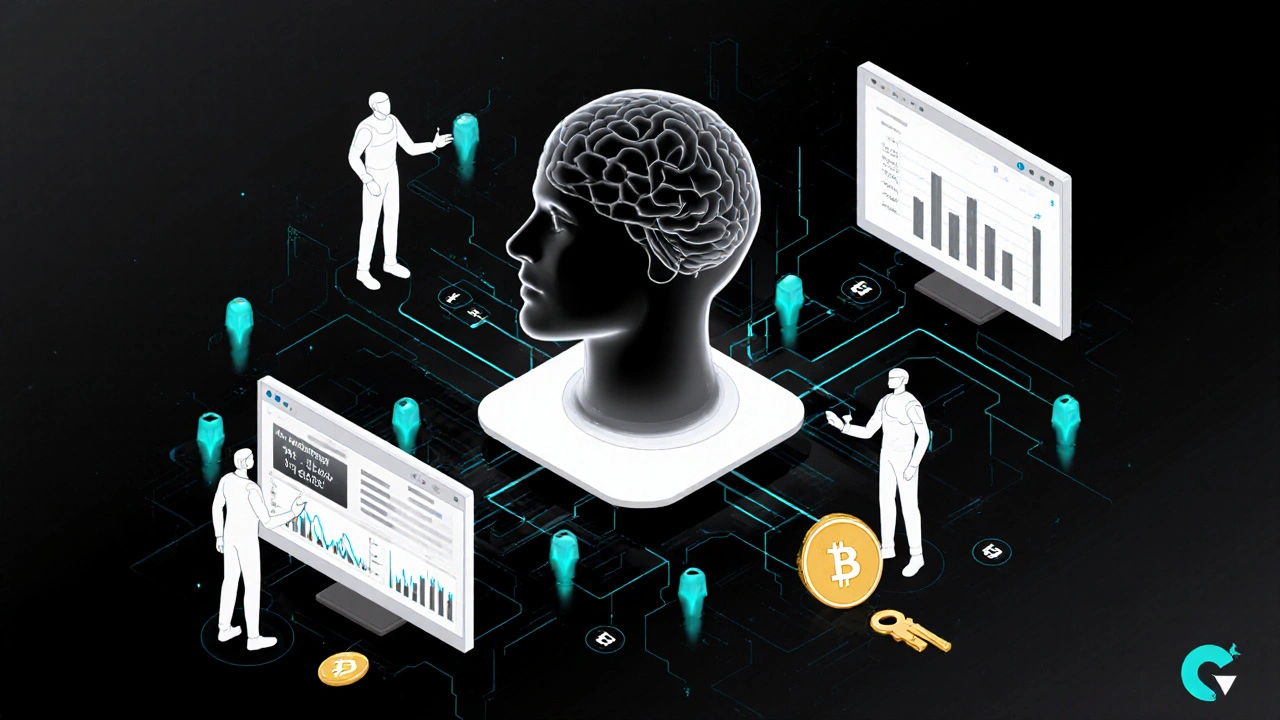Imagine waking up to find your crypto portfolio automatically rebalanced, your ETH swapped for USDC at the best rate, and your staking rewards claimed-all while you were asleep. No taps. No apps open. No thinking. This isn’t science fiction. It’s happening right now, powered by AI agents with wallets in Web3.
What Exactly Is an AI Agent with a Wallet?
An AI agent with a wallet is a software program that runs on blockchain networks, makes decisions using artificial intelligence, and executes transactions using its own digital wallet. Unlike traditional crypto wallets where you manually sign every transaction, these agents act like tireless financial assistants. They watch markets 24/7, analyze on-chain data, and act without human input-unless you set rules that say otherwise. These aren’t simple bots. They use large language models (LLMs) to understand context, learn from past trades, and adapt to changing conditions. If gas fees spike on Ethereum, they’ll switch to Polygon. If a token’s liquidity dries up, they’ll move to a different exchange. They don’t panic. They don’t FOMO. They just optimize. The wallet part is key. These agents don’t use your personal wallet directly. Instead, they’re granted limited, secure access through something called a sovereign wallet. This wallet uses threshold signatures (like ECDSA or Schnorr) so no single point can be hacked. Even if the AI is compromised, it can’t drain funds without multiple cryptographic approvals.How Do These Agents Actually Work?
At their core, AI agents with wallets follow a supervisor-collaborator model. Think of it like a team:- The supervisor is the brain. It gets your goal-like “maximize yield” or “protect against volatility.”
- The collaborators are specialists: one checks token prices, another estimates gas fees, a third scans for new DeFi pools, and another watches for suspicious activity.
Real Use Cases Beyond Just Trading
Most people think AI agents are just for trading. But their real power is in automation across Web3:- DeFi Portfolio Management: Agents automatically rebalance your holdings when market conditions shift. If ETH drops 15%, they might shift 20% into staked ETH or stablecoins based on your risk profile.
- NFT Yield Farming: Some agents monitor NFT marketplaces for underpriced collectibles, buy them, list them for rent, and reinvest rental income into staking pools.
- Proactive Security: CertiK’s AI agents detected 92% of flash loan attacks in Q1 2024 by spotting unusual transaction patterns before they happened. They can freeze a wallet or alert you before funds are drained.
- Game Economy Automation: In Web3 games, agents can farm resources, trade items, and manage in-game currency so you don’t have to grind 8 hours a day.
- Subscription Payments: Imagine paying for a decentralized news site or a DAO’s content feed automatically using your agent. It checks your balance, approves the fee, and pays in ETH or USDC-no invoices, no reminders.

The Tech Behind the Magic
Building an AI agent with a wallet isn’t plug-and-play. It requires three core components:- Blockchain Access: The agent needs RPC endpoints to read and write to chains. AWS Managed Blockchain and Infura are common choices.
- On-Chain Data: It needs indexed datasets-like The Graph or Dune Analytics-to quickly query token prices, wallet histories, or liquidity pool sizes.
- A Secure Wallet: Sovereign wallets with multi-signature or threshold cryptography are mandatory. Single-key wallets are too risky.
Challenges and Risks
This tech is powerful-but far from perfect.- Gas Fee Guessing: MIT’s June 2024 study found 12-18% of cross-chain agent transactions fail because agents misestimate gas fees across different EVM chains. One agent tried to swap on Optimism but didn’t account for its unique fee structure. The transaction failed, and the agent kept retrying-burning $1,200 in wasted gas.
- The Oracle Problem: AI agents rely on external data feeds (prices, news, trends). If those feeds are wrong or manipulated, the agent acts on bad info. Vitalik Buterin warned this could trigger cascading failures across DeFi.
- Regulation: The SEC says AI agents that execute financial trades may qualify as unregistered investment advisors. That’s a legal gray zone. If your agent buys and sells tokens automatically, you could be liable.
- Global Compliance: Agents struggle with regional rules. A U.S.-based agent might auto-sell tokens when prices drop, but in Germany, that could trigger capital gains reporting. Chainalysis found 67% of agents fail to handle cross-border compliance correctly.

Who’s Leading the Charge?
Three types of players dominate the space:- Cloud Providers: AWS Bedrock and Google Vertex AI lead in enterprise adoption. AWS has 48% market share among Fortune 100 companies using AI agents, per 451 Research.
- Blockchain-Native Platforms: Fetch.ai and Internet Computer Protocol (ICP) are built from the ground up for agents. ICP handles 63% of all agent-to-agent transactions, according to Flipside Crypto.
- DeFi-Specific Tools: Hummingbot and Tender let traders automate strategies like arbitrage or liquidity provision without coding.
What’s Next? The Future of Autonomous Commerce
The biggest shift coming isn’t just better agents-it’s embedded agents. Lync.world’s May 2024 analysis found AI wallets are starting to live inside apps, websites, and even smart devices. Imagine this: You’re browsing a Web3 marketplace for digital art. You click “Buy Now.” Instead of signing a transaction, you see: “Your AI agent has $1.2 ETH available. Approve?” You tap yes. The agent handles the rest: checks price across 5 chains, pays in the cheapest gas, and sends the NFT to your wallet-all in 4 seconds. That’s the future. And it’s not far off. The World Wide Web Consortium launched a working group in June 2024 to standardize agent-to-agent (A2A) communication. That means agents from different platforms will soon be able to negotiate, trade, and collaborate-like humans do. Andreessen Horowitz’s Chris Dixon predicts AI agent wallets will handle 30% of all Web3 transactions by 2027. That’s $100+ billion in automated commerce. But here’s the catch: without standardized security frameworks, Panewslab warns these agents could increase the attack surface by 200-400% compared to traditional wallets. The tech is moving fast. The safety nets aren’t.Should You Use One?
If you’re holding crypto and not actively managing it, you’re already behind. AI agents with wallets aren’t for everyone-but they’re not just for devs anymore. Start small:- Use Hummingbot to automate simple arbitrage on your stablecoins.
- Try a custodial service like Coinbase’s AI-powered portfolio rebalancer.
- Set up a basic agent on AWS Bedrock to monitor your ETH balance and auto-swap to USDC if it drops 10%.
What is an AI agent with a wallet in Web3?
An AI agent with a wallet is a software program that uses artificial intelligence to make decisions and execute transactions on blockchain networks using its own secure digital wallet. Unlike traditional wallets that require manual signing, these agents operate autonomously-buying, selling, swapping, or staking crypto based on predefined rules or learned patterns, without human intervention.
Are AI agents with wallets safe?
They can be, but only if built correctly. Early implementations had serious security flaws, with 63% of early projects having wallet signing vulnerabilities. Safe agents use sovereign wallets with threshold signatures (like ECDSA or Schnorr), hardware-secured keys, and multi-factor authentication. Platforms like AWS Bedrock and Google Cloud now integrate hardware security modules (HSMs) to protect private keys. Never use an agent with a single private key or hardcoded credentials.
Can AI agents make money for me?
Yes, but not guaranteed. AI agents can maximize yield by automatically switching between DeFi protocols, rebalancing portfolios, or capturing arbitrage opportunities. Some users report 15-30% higher returns than manual management. However, they can also lose money if they misread data, face high gas fees, or act on faulty inputs. Always set strict limits, test in simulation mode first, and never let an agent control your entire portfolio.
Do I need to be a developer to use an AI agent?
No. While building your own agent requires coding skills (68+ hours of work for basic setups), you can use ready-made tools like Hummingbot, Coinbase’s AI rebalancer, or AWS Bedrock’s pre-built templates. These let you configure goals-like “maximize yield” or “protect against volatility”-without writing a single line of code.
Are AI agents legal?
The legal status is unclear. The SEC has stated that AI agents executing financial transactions may qualify as unregistered investment advisors, which could require licensing. In the U.S., if your agent buys and sells crypto on your behalf regularly, you may be legally responsible for its actions. Always consult a financial or legal advisor before deploying autonomous agents for trading or portfolio management.
What’s the biggest risk with AI agent wallets?
The biggest risk is systemic failure due to bad data or untested logic. If an agent relies on a manipulated price feed (an “oracle” problem), it could trigger mass sell-offs or bad trades across hundreds of wallets. MIT’s 2024 study found 12-18% of cross-chain agent transactions fail due to gas fee miscalculations. Without standardized security and communication protocols, these agents could become a major attack vector-potentially increasing the Web3 attack surface by 200-400%.



pk Pk
November 25, 2025 AT 21:53This is wild. I set up a simple agent last week to auto-swap ETH to USDC when it dips 5%. It did it three times in 48 hours and saved me from a 12% drop. No more staring at charts at 2am. 🙌
Shivani Vaidya
November 26, 2025 AT 18:16The technical architecture described here is both elegant and deeply concerning. While the efficiency gains are undeniable, the regulatory vacuum surrounding autonomous financial agents remains perilous. Without standardized governance frameworks, we risk systemic instability driven by algorithmic consensus failures. This is not merely a technological evolution-it is a paradigm shift demanding urgent policy intervention.